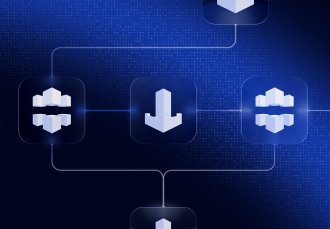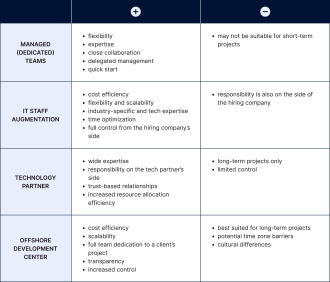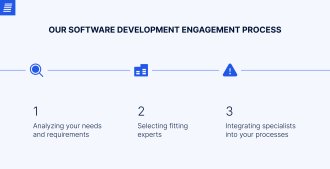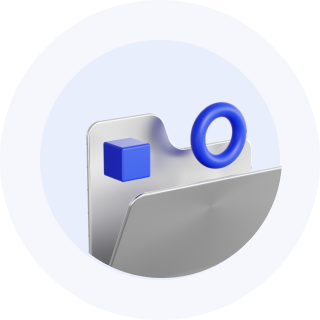
Contact us
Our team would love to hear from you.

In this article, we will explain what an engagement model is, describe the four main types, and provide guidance on how to select the best option.
In software development, an engagement model is a collaborative framework between an IT service provider and a client for a project. It delineates the obligations, responsibilities, scope, and duration of the project, as well as other partnership terms, forming the basis for the business relationship between the two parties.
Choosing the right IT engagement model is key to project success, as each serves different goals: there is no one-size-fits-all option. Knowing the specific needs and desired outcomes of the project is essential to enable the selection of the most appropriate software development engagement type.
Regardless of the chosen model, outsourcing specialists in software development brings substantial benefits. It typically reduces cost, adds value to the developed product through expertise, and is more flexible than having an in-house team.
IT engagement models vary depending on the working mode, terms and conditions of the partnership, and other factors. The following four are the most popular types of engagement models, along with their advantages and drawbacks.
A managed development team is a business engagement model in which an entire team of professionals is hired to work exclusively on a particular project according to a client’s requirements. A provider company arranges a dedicated, self-sufficient team, which can include various specialists depending on the project’s requirements, such as front-end and back-end developers, user interface/user experience (UI/UX) designers, quality assurance (QA), business analysts (BA), DevOps engineers, data scientists, and more. In this type of engagement, a project manager plays a crucial role by immersing themselves in the specifics of the project and serving as a link between the hiring company and the managed team.
This model offers a flexible and collaborative approach to software development, with the opportunity to scale the size of the team up or down as needed. An IT service provider bears all the administrative responsibilities while the client focuses on the business goals.
A managed team is a good fit when a client has a long-term project but lacks an in-house team to implement it. It is also suitable when the skills of the in-house team are insufficient for a certain task or project. For those comfortable entrusting product development to tech experts who know how to bring an idea to life in the best way possible, a managed team is the perfect choice.
IT staff augmentation involves outsourcing temporary personnel to meet particular technical needs and project goals. This model allows for quick team scaling, eliminating the time required for recruitment and onboarding because competent candidates from the vendor’s side can start on the project right away. It is also a cost-efficient form of cooperation, as the hiring company is relieved of additional expenses such as days off, leaves, bonuses, and taxes.
Providing access to a global talent pool, this project engagement model is suitable for companies seeking to close skill gaps, reinforce their teams with additional experts, or add specialists with niche skills.
For some companies, software development is just one element of an overall digital transformation. In these cases, it is worth turning to a technology partner to ensure success. Tech partners provide a holistic view that involves assessing the client’s market position, crafting the product concept, establishing development goals and milestones, and providing consultation and advice throughout the development lifecycle. This custom engagement model entails deep involvement in a company’s processes, analysis of its business needs, and formulation of effective solutions.
This engagement option is ideal for companies that have a concept for a digital product but require assistance in creating a detailed execution plan and need IT support throughout the development process.
Competition has consistently been a driving force in the business sector, prompting enterprises to seek sophisticated methods of navigating the fast-paced business environment.
An offshore development center (ODC) is a business engagement model where a client company partners with a software development vendor to establish a dedicated team as a separate legal entity in a foreign country. This offshore unit functions as an extension of the in-house team, custom-tailored to meet the requirements of the client’s particular project. An ODC includes a cross-functional team fully committed to the client’s tasks and equipped with the necessary infrastructure for product development. ODCs are typically formed in countries with lower labor and infrastructure rates, helping companies reduce costs.
Companies that want to capitalize on a highly qualified development team at a reasonable price will find ODC a suitable project engagement model.


Before deciding on a software development engagement model, it’s important to consider several crucial aspects and answer a few questions. This will help you select the most beneficial option for your project.
Do you need to augment your team with an additional specialist or an expert in a particular area? Do you want to hire an entire team to implement a task or fulfill a project? Do you need help building your strategy? These are all relevant questions for companies aiming to select an IT vendor and engagement model that best suits their needs.
Tech-savvy companies have the necessary expertise to manage teams and processes; therefore, they may not need models that involve a technology partner. In cases where expertise in a specific area is lacking, staff augmentation can effectively address the gap.
The scope of work influences the choice of engagement type. Projects that constantly evolve and expand require a flexible approach. Conversely, projects with well-defined descriptions and roadmaps may find models with fixed price and scope more suitable.
Budget plays a significant role in selecting an appropriate cooperation model. A company with limited resources may opt for engagement models with fixed prices. For projects with few constraints, flexible and scalable models are more beneficial.
Different software development engagement models in IT offer various levels of cooperation and communication. Dedicated teams and staff augmentation involve close collaboration and supervision, while working with a technology partner suggests a high level of engagement with limited control. By choosing an ODC, companies entrust software development to the outsourced team almost completely.
The choice of software development engagement model also depends on the size of your existing team and whether you need to fill a certain position or assemble a team from scratch.
Some engagement models are more effective at particular stages of product development. For example, a technology partner works from the ideation stage while augmented staff can join a project at practically any time.
As an outsourcing software product development company, EffectiveSoft is dedicated to creating solutions that make a difference. We gather and carefully analyze a client’s requirements and evaluate their needs in terms of product concept, budget, and deadlines. We also consider factors like the phase of the project, the preferred level of engagement and cooperation, and the presence of an in-house team.
Before the collaboration begins, a non-disclosure agreement is drawn up. This ensures the necessary level of security and confidentiality to protect the client’s sensitive information.
Next, we choose the necessary experts to enhance your team or put together a full team to work on your project. We select candidates from our talent pool based on the relevance of their skills and knowledge to the tasks at hand.
Our cooperation process varies depending on the chosen engagement model but primarily consists of the following stages:


Engagement models in IT vary depending on the involvement and expertise of the hired specialists, the development approach, the level of flexibility, and many other aspects. Conducting a thorough analysis of the pros and cons of each model, coupled with an evaluation of your specific requirements, simplifies the process of selecting the engagement model that will enhance your team and drive your project to success.
As an outsourcing company, we offer a holistic approach to meeting all client needs using the most appropriate engagement model. Contact the experts at EffectiveSoft to explore our offerings and learn how we can help make your project a success.

There is no one software development engagement model that is most cost-effective—it depends on your requirements and the specifics of your project. The model that most closely matches your requirements will be the most cost-effective for you. Finding the right fit requires a thorough analysis of the scope of work and complexity of the project and a comprehensive evaluation of the pros and cons of each engagement model.
Software delivery speed depends on the project’s objectives and scope. Engagement models with fixed price and scope have well-defined deadlines and require a comprehensive planning phase, which helps prevent overruns. Other types have less clear time limits but can be time-efficient, especially when supported by an experienced development team.
In software delivery, risk is not connected to a specific engagement model but rather to selecting the model that best aligns with the project requirements. To mitigate risks, companies must approach the selection of the engagement type and their outsourcing partner with responsibility and diligence.
At EffectiveSoft, we see the discovery phase—in which we analyze and evaluate the needs and requirements of our clients—as the foundation of the entire project. During this phase, it is crucial to carefully assess all potential risks in order to address them promptly or prevent them altogether.
Staff augmentation, dedicated teams, technology partners, and ODCs are the main types of business engagement models. However, fulfilling all project requirements with a single model is sometimes challenging. In such instances, a hybrid model is the appropriate choice, as it combines features of different engagement types and offers a customized approach to cooperation between an IT services provider and a client company.
Can’t find the answer you are looking for?
Contact us and we will get in touch with you shortly.
Our team would love to hear from you.
Fill out the form, and we’ve got you covered.
What happens next?
San Diego, California
4445 Eastgate Mall, Suite 200
92121, 1-800-288-9659
San Francisco, California
50 California St #1500
94111, 1-800-288-9659
Pittsburgh, Pennsylvania
One Oxford Centre, 500 Grant St Suite 2900
15219, 1-800-288-9659
Durham, North Carolina
RTP Meridian, 2530 Meridian Pkwy Suite 300
27713, 1-800-288-9659
San Jose, Costa Rica
Escazú Corporate Centre, Piso 6
40602, 1-800-288-9659